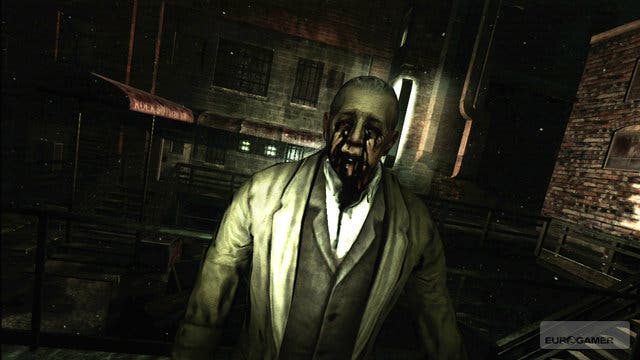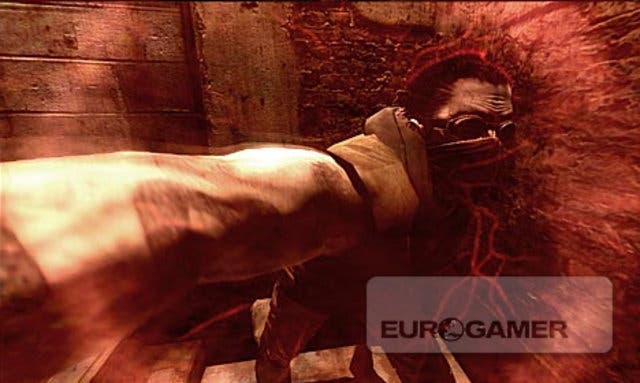Condemned 2: Bloodshot
Tramp stamp.
Once you've got beyond the initial tutorial rampage, the game moves onto another dark, gloomy crime-solving caper, as you're roped back into working with the Feds, despite being a hopeless, babbling, delusional drunk. 'Caper' is probably the last word you'd use to sum up Thomas' unhappy trails, but it essentially involves hunting for Darcy, your former partner, as well as going after Leland Vanhorn, the 'killer of serial killers', apparently in an even more grisly state than before. Along the way, the game imparts sinister new information by allowing you to 'tune in' TVs that you come across, a familiar narrative device to the ones used in The Darkness or Max Payne, among others.
Forensics is also a key element, although we've not seen much of it yet. You might recall that the original rather spoilt the investigative side by leading you completely by the hand. This time, Monolith encourages players to solve problems themselves, giving you a multiple-choice list of possible answers to help observe the crime scene. Is it an entry or exit wound? Was he dragged? Ooh, let's see where the blood trail leads. That sort of thing. It's hardly a challenge, but, to be fair, this is the start of the game, so it's reasonable to expect greater difficulty later on.

Speaking of which, the game did start to take the stabilisers off, offering you the option to check out evidence, but not actually enforcing it. As Monolith has stated previously, you won't actually be forced to investigate anything, although obviously the more elements of the game you complete, the more Achievements you'll earn, and so on.
One of the most impressive aspects we observed in our three-hour playtest was just how far the visuals have come along. Built in just 15 months, Condemned was certainly one of, if not the best launch title for 360 [nonsense, it was PGR3 - Ed], but since then Monolith has built up the engine to rank among the most impressive of the generation. Texture work in particular has improved considerably, allowing the artists to create almost unbearably dismal locales, which impress in their ability to convey festering decay (The Collective certainly has some work to do if it's to make Silent Hill 5 comparatively grim).

Just as impressive are the character models - not just in the detail levels, but the animation. Sitting back and watching someone else play, a lot of the incidental detail and subtleties shone through in a way that wasn't especially evident with the pad in hand. When you sit back and admire what Monolith has done with animation, it becomes apparent why the melee combat feels convincing; everything connects the way it should, fist on bone, pipe on cranium. It's not pretty to watch, but that's the whole point.
Although we didn't get time to try out the multiplayer mode, so far we've gleaned the following: it will consist of Deathmatch Team Deathmatch, Bum Rush (tramps versus agents, essentially, with the agents unable to respawn) and Crime Scenes, another tramps-versus-feds mode, with the tramps hiding evidence and the agents finding it using their equipment. Sounds fancy [sounds deeply sinister to me - Ed].
Needless to say, we'd like to play more, so we'll be pestering SEGA daily ahead of the game's 14th March release on 360 and PS3. Look out for our review nearer the time.

